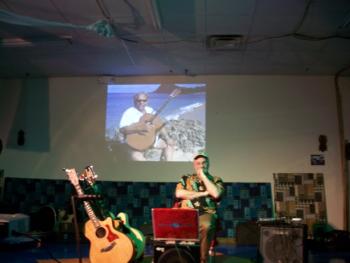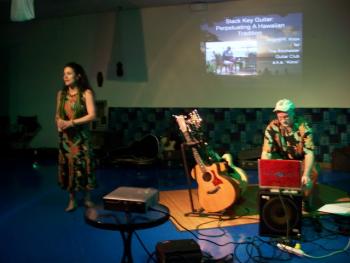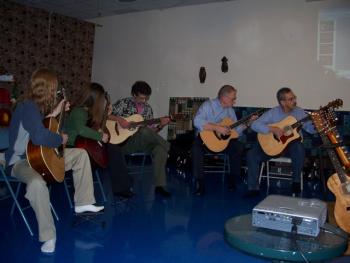Wayne Kimo Knox (January 13, 2008)

Wayne and a Hawaiian hero
On a cold winter’s night in Rochester the next best thing to a trip to Hawaii is an evening at the Gallery Kauai Center for Hawaiian Studies and Performing Arts on Jefferson Road! Wayne Kimo Knox and his wife, Kumu Victoria Ka’iulani Visiko in their Hawaiian personae, Kimo and Ka’iulani treated the Guitar Club to a charming multimedia presentation of Hawaiian art and culture focusing on the Hawaiian guitar style known as Slack Key guitar. The room is tastefully and cheerfully decorated with bright, warm colors providing an ideal setting for an evening of poetry, music and dance Hawaiian style. It became apparent through the evening that the Hawaiians had long ago learned to live in harmony with nature and themselves with this knowledge pervading every aspect of their lives. Their peaceful culture was intruded upon in the nineteenth century by marauding European Missionaries, but today is once again perpetuating its heritage and sharing it with the rest of the world. Both Kimo and Ka’iulani have dedicated themselves to this purpose. Their studio is one of only a few of its kind in New York State. It has been in operation since 2001 giving instruction in Slack Key guitar, Ukulele, Hula and other Polynesian dance styles.
Wayne is Director and Professor of Optics and Physics at the University of Rochester. He is also musically educated having studied flute at the Eastman School, and played bass with Joe Locke among others. He also studied lute with Paul O’Dette. Through these early music studies he became familiar with tablature which is extensively used in notating Slack Key guitar. In Hawaii Wayne is known as the “White Hawaiian”, although he says that he is more often the red Hawaiian! Wayne may have the appearance of a Mainlander in spite of his floral-print attire, but close your eyes and you will hear a Hawaiian guitarist.

Kimo and Ka’iulani
Kimo and Ka’iulani artfully accomplished their goal for the evening through a variety of aural and visual media. The presentation was introduced with a lovely chant by Ka’iulani dedicating the space to its purpose for the evening. Ka’iulani is a natural in her Hawaiian role. With long black hair, gentle Eurasian features, flowing movements and speech it is hard to believe that she was not actually a native-born Hawaiian.
Knox was well prepared for his task with an array of guitars ready to play in various tunings the evening’s selections in addition to carefully chosen video clips and recordings. “After all, an artist does not paint with only one brush!” Kimo’s musical examples exhibited a depth and complexity far beyond what has often been associated with Hawaiian music in recent years.
Kimo’s first piece was performed on a twelve-string guitar tuned to an open F Major chord, CFCFAC. He had only learned Nu ‘Oli on the previous Friday which you would never have known if he hadn’t mentioned it. The Takamine twelve-string guitar tuned in octaves and unison had also been recently acquired. Kimo’s skillful and sensitive playing made it plain that the twelve-string instrument is as capable of gentle nuances as the six-string version. Hawaiians eschew loud and abrasive music just as they prefer to avoid conflict and violence in their culture.

The most striking feature of Hawaiian guitar playing is the Slack Key tuning. Slack does not mean sloppy! The term refers to what we call alternative tunings, and Kimo uses up to 30 different tunings. Scarcely any two tunes are played in the same tuning. Players hardly think in terms of scales and chords, but instead memorize patterns and use tricks to remember the patterns for each song. The goal of the various tunings is to create a radiant space in which to play. Ideally, the instrument will disappear leaving only the player and the music. This is another way of saying that the instrument is a tool and not an end in itself. The various tunings were once considered top secret because the Hawaiians had found that everything they shared with the outside world became lost or misused. However, this eventually began to change when it became apparent to them that if they did not pass on their knowledge to the younger people it would, indeed, become lost.
Kimo prefers to use light-gauge strings on all his guitars. Since the strings are constantly being retuned he always needs to keep an extra supply on hand! One of the instruments in Kimo’s battery was a Takamine classical guitar with built-in “cool tube” pre-amp and a Piezo pickup. It was strung with nylon strings as usual, but tuned to CFCGCE and fitted with a capo at the third fret. To my ears, the nylon-string guitar seemed particularly suited to the delicate Hawaiian style. The effect was, as Kimo put it, like warm butterscotch! Interspersed with Kimo’s delightful selections were clips from videos illustrating Slack Key guitar or explaining Hawaiian history and way of life. As Kimo or a player on the screen would play, Kimo sometimes pointed out particular points of technique. To maintain a tranquil, personal sound Hawaiians play their guitars unamplified and therefore prefer instruments with good projection and a strong bass. The lower string is tuned down as low as C or, occasionally, Bb. Most Hawaiian melodies are in major keys, but occasionally in minor. There are different traditions about how the guitar first came to Hawaii. Most likely, it was brought by Mexican or South American vaqueros in the 19th century along with other features of the cowboy tradition.
Kimo finds that classical players often have a head start compared to flat pickers since they already are accustomed to finger picking. Students are also taught to take advantage of open strings. At times, only a thumb and one or two left-hand fingers are required to set up a right-hand pattern. The player also needs to learn when to dampen bass strings so that their sound does not muddy subsequent arpeggios. The traditional sound of Hawaiian guitar is soothing and sweet; this effect is known as “nahenahe”.

Following Kimo’s fascinating presentation, four of his students demonstrated what they had learned. They were joined by Kinloch Nelson of the Guitar Club who had recently played with Kimo. Rather than leading them, Kimo left them to their own devices. They handled themselves with confidence and dedication in a calm and competent performance of Moe ‘Uhane, or Dream Slack by Sonny Chillingworth.
As the evening had begun with Ka’iulani, it came to a conclusion with a delicate dance in which she was joined by two of her dance students. The entire evening was truly a breath of fresh air, and I left the studio feeling better for the experience — Nahenahe!
Kimo’s suggested resources for interested guitarists:
Learn to play Slack-Key Guitar by Keola Beamer and Mark Nelson, Mel Bay MB96695BCD
“Masters of Hawaiian Slack Key Guitar” by Mark Hanson, Accent on Music, PMB#252
Secrets of Contemporary Slack Key Guitar by Daniel Ho and Steve Sano, Alfred Publishing Co. ISBN 0-7390-1236-3
www.TaroPatch.net
www.dancingcat.com/dancingcat/
...and particularly go to: http://www.dancingcat.com/skbook-tableofcontents.php
www.GalleryKauai.com
R. Taglieri
Photos: K. Nelson
Home ::
About Us ::
Events ::
Articles ::
Resources ::
Contact Us ::
Links
©2007-2008, Rochester Guitar Club, All Rights Reserved, This page last updated 2008-02-07 06:45:48
Website by Red Beagle Web Development.








